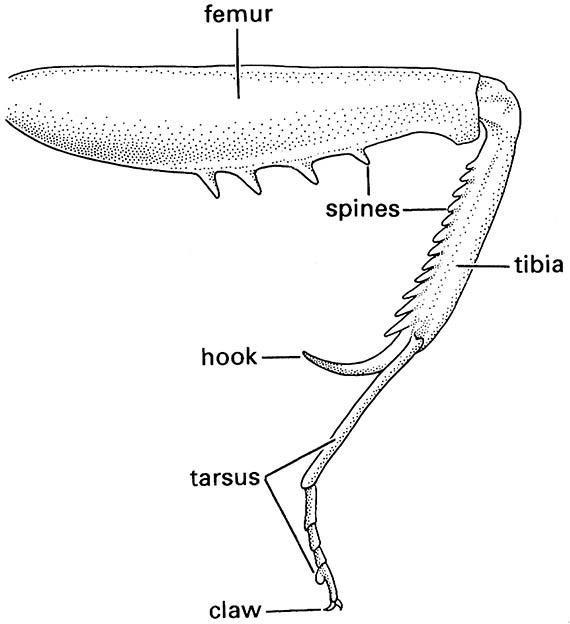Box 13.2. Mantodea (mantids)
The Mantodea is an order of about 2000 species of moderate to large (1–15 cm long) hemimetabolous predators classified in eight families. Males are generally smaller than females. The head is small, triangular and mobile, with slender antennae, large, widely separated eyes, and mandibulate mouthparts. The thorax comprises an elongate, narrow prothorax and shorter (almost subquadrate) meso- and metathorax. The fore wings form leathery tegmina, with the anal area reduced; the hind wings are broad and membranous, with long veins unbranched and many cross-veins. Aptery and subaptery are frequent. The fore legs are raptorial (Fig. 13.3 and as illustrated here for a mantid of a Tithrone species holding and eating a fly, after Preston-Mafham 1990), whereas the mid and hind legs are elongate for walking. On the abdomen, the 10th visible segment bears variably segmented cerci. The ovipositor is predominantly internal; the external male genitalia are asymmetrical.
Eggs are laid in an ootheca (see Plate 3.3, facing here) produced from accessory gland frothy secretions that harden on contact with the air. Some females guard their ootheca. First-instar nymphs do not feed, but molt immediately. As few as three or as many as 12 instars follow; the nymphs resemble adults except for lack of wings and genitalia. Adult mantids are sit-and-wait predators (see section 13.1.1) which use their fully mobile head and excellent sight to detect prey. Female mantids sometimes consume the male during or after copulation (Box 5.2); males often display elaborate courtship.
Mantodea are undoubtedly the sister group to the Blattodea (cockroaches) and Isoptera, forming the Dictyoptera grouping (Figs. 7.2 & 7.4).


(After Preston-Mafham 1990)

Broken lines indicate uncertain relationships. Thysanura sensu lato refers to Thysanura in the broad sense. (Data from several sources)

The broken line indicates a paraphyletic taxon. (Data from several sources)



